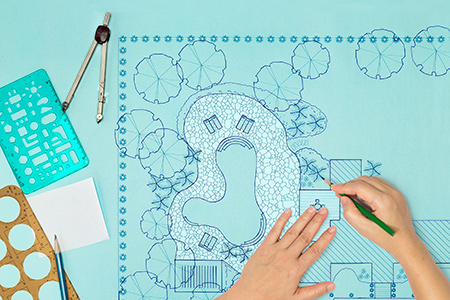Courses Available
 There are many garden design courses available, with different time commitments, fees and focus, so it might seem difficult to choose the right one.
There are many garden design courses available, with different time commitments, fees and focus, so it might seem difficult to choose the right one.
We believe the information below should help anyone thinking of training in garden design.
Educator Status
The Society of Garden Designers (SGD) does not approve or validate schools or colleges, but we do award ‘Educator Status’ to courses offered at Level 3 and above, and where the designated programme leader or course tutor has been approved.
Being awarded SGD Educator Status means that a course is committed to high standards in garden design education and teaching of best practice, as well as allowing for reviews of students’ work.
Those studying on these courses are encouraged to become Student Members of the Society and continue afterwards on the professional pathway to Registered Membership.
View our list of courses with SGD Educator Status.
 How to choose a garden design course
How to choose a garden design course
When considering a course, find out where the emphasis will be – you may want one that spends more time on construction or horticulture, or is arts based.
You will want to learn from those who have real-world experience, so ask if the course tutors are practicing designers who are professionally trained.
How many graduates go on to find work or start successful businesses, and what opportunities are available for further study after the course?
Work experience is invaluable for students. Discover if placements are part of the course, or if the course has links within the industry to help you find one. It is also worth finding out if the course is externally accredited and uses external examiners.
Design
A course should cover the main aspects of the design process and train you to create appropriate visuals and documentation for a project. These would include presentation plans and drawings, site surveys and analysis, detailed construction drawings and setting out drawings, as well as teaching you how to specify materials.
It’s a good idea to find out how many complete garden projects (and not just tasks) will be covered in the course – the more, the better – and if these include different kinds of garden, such as large rural or small urban sites as well as difficult elements such as slopes and gradients.
Ask how much studio time there will be for design teaching and how much tutor supervision is included. Find
out if students gain experience in pitching and presenting their ideas as they would to clients.
 Skills
Skills
A garden design course should train students in a range of skills, including practical horticulture and construction, as well as hard and soft landscaping (plant identification and maintenance). A working knowledge of computer aided design (CAD) should be included and hand drawing classes are always helpful.
Business
Find out if students learn about communicating with clients, contractors and others involved in the process, and the contracts, laws and legal responsibilities that are part of garden projects. Will you be taught about setting up your own business, marketing and book keeping?
Use these tips as a starting point, and if possible visit the school and talk to the tutors, students and alumni, and see past and present work.
Then, fully informed, you can decide which course is best for you.